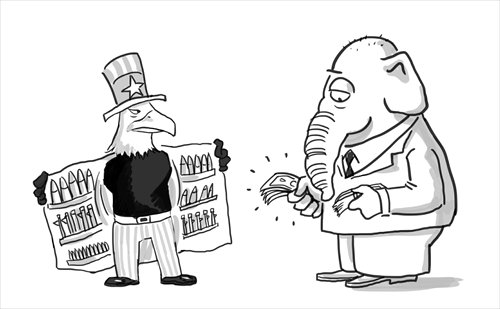HOME >> OP-ED
Tougher negotiations will follow pomp of Obama visit
Source:Global Times Published: 2015-1-27 20:33:01

Illustration: Liu Rui/GT
In a symbolically important move, US President Barack Obama attended India's annual Republic Day parade as a chief guest despite the rain on Monday, the second day of his visit to India. He was the first ever US head of state to be invited for the event and even the White House was slightly surprised at the honor.Obama started his three-day visit with a bear hug from his Indian counterpart Narendra Modi who even broke with protocol to greet Obama at the airport. The two biggest democracies in the world have apparently attached great importance to the event as this is the first time a sitting US president has paid a second visit to India.
The two sides emerged with a "breakthrough understanding" on a civilian nuclear deal despite US worries about India's laws on liability over accidents, though it will take time to see any practical follow-ups.
While announcing they would increase their bilateral trade by five times from the current $100 billion to $500 billion annually, they also agreed to renew a 10-year defense pact and pledged to deepen defense cooperation that included the joint production of drones and equipment for Lockheed Martin Corp's C-130 military transport plane.
The two heads of state spoke highly of their bilateral relationship, a very important one in the world.
Modi said that Obama's visit "reflects the transformation in our relationship," and said India and the US "are prepared to step forward firmly to accept the responsibility of this global partnership."
Meanwhile, Obama said the two countries "had declared a new friendship to elevate our partnership," which "will remain a top foreign policy priority" for his administration.
However, Washington always draws a clear boundary between countries like India, which is only a strategic partner, and the long-standing alliances it has built with Japan and South Korea.
The seemingly enthusiastic approaching of the US and India and the bromance between the two leaders do not suggest any substantial improvement in the bilateral ties of the two countries.
High-sounding remarks and deals are often showcased during high-level visits between the US and India, but when the trips end, actions often lag behind and words fail to translate into visible actions. The latest visit will likely repeat this pattern.
The US is looking toward India as a regional partner in South Asia and the Indian Ocean to coordinate with its "pivot to Asia" strategy and as a counterweight to a rising China. It also needs India's cooperation in international affairs given New Delhi's increasing sway in the international community.
While India values its strategic partnership with the largest economy in the world for the sake of its national interests, the US sees India as a vast market that can offer a large pool of investment and trade opportunities, but is reluctant to give what New Delhi wants most; joint research and production of the cutting-edge weapons. There are difficult negotiations and talks ahead before both sides' expectations can converge .
After Modi took office in May last year, New Delhi has been seeking to improve its roller-coaster relationship with Washington and in the meantime actively develop its relations with other powers in the world.
India intends to maximize its interests from the important relationship with the US, but it has its own strategies to follow and carefully measures its critical relations with other big powers such as China.
New Delhi will not easily alter its basic national policy of independence and nonalignment and do what Washington says to take sides. It is better not to read too much into Obama's visit despite the pomp and pageantry.
The article was compiled by Global Times reporter Sun Xiaobo based on an interview with Zhang Li, a professor with the Institute of South Asian Studies, Sichuan University. sunxiaobo@globaltimes.com.cn
Posted in: Debate